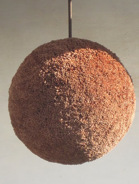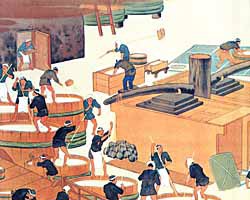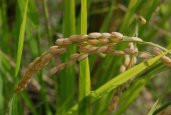|
|
|
Late-Summer Greetings to all readers,
Or as they say in Japanese, "Zansho O-mimai Moshiagemasu," or
greetings in the lingering heat of the end of summer. As fast as just about every year, the summer is all but gone. With all that has been happening in the world these days, it seemed a tad less summer-ish than most, although perhaps that is but my own perception.
And another hot one it was. This affects rice a great deal, making it less soluble and harder for brewers to extract flavor and breadth in their brews. Still, last year was horrendous and the brewing industry as a whole tweaked their processes well enough to render negligible the effects of the heat. But can they do it again this year? Every year is different. Only time will tell.
How the sake of Tohoku (and the industry as a whole) will fare after last March’s triple tragedies remains to be seen as well. So far so good: people are drinking Tohoku sake and overall consumption numbers are not that bad, considering recent trends. But will it continue? Let us hope so and do what we can to help. (And you know what that means!)
You may have noticed that there was no newsletter from me last month! While I try to get this newsletter out dutifully, regularly, punctually and religiously, every year I end up letting myself off the hook one time. And that one time was this past month. For those of you filing them assiduously, I apologize for messing with your system.
Also, please note the announcement of the Sake Professional Course scheduled for December 5 to 7 in Las Vegas. What happens with sake stays with sake.
Enjoy the newsletter as well as the approaching autumn,
John
 
|
Rice Report
A Potpourri of Grainy Facts
This month, let us look at a bunch of facts and observations about
rice of recent in Japan.
~ The government of Japan has asked 17 prefectures in the eastern half of the country to test soil for radiation. The area in question covers 54 percent of all domestic rice production.
~ Rice is planted between April and June and as such the planting itself was done after radiation levels everywhere had fallen significantly. Also, Mr. Shigeo Uchida, an agronomist (a whu?) at the National Institute of Radiological Sciences has stated that “Generally, cesium does not spread much from soil to grains.”
~ Also, bear in mind that much (dare I say most?) of the really good sake rice is grown out west, Hyogo, Okayama, Fukuoka, Tokushima… far from the Tohoku region and far from Fukushima. Certainly much great sake rice comes from the northeast as well, but my point is that supplies of good sake rice will not be compromised by the March tragedies.
~ So far, so safe. Thus far, all rice checked anywhere – including Fukushima Prefecture (wherein the nuclear reactor Fukushima Dai-ichi sits) has tested clean of cesium.
~ This dadburned heat affects rice quality. As mentioned above, when the summers are too hot (and when the nights do not cool off sufficiently), the starches created do not dissolve as well. This makes it hard to get any real depth or breadth of flavor out of the rice during fermentation. But brewers adjust by letting the rice absorb a bit more water, among other things.
~ Usually one will see the effects of a bad year most readily in contest sake or daiginjo, rather than sturdier stuff. But last year’s was not bad at all, certainly not even close to the disastrous predictions.
~ One toji (master brewer) has suggested that just because the industry did well last year, does not mean they can repeat the feat. Things are different ever year, and it is conceivable that brewers could become overzealous in their efforts to tweak things, and send flavors into roughs-ville by so doing.
~ When putting statistics together for the rice chapter for the Sake Professional Course in New York last month, I was astounded to see just how little top-grade rice was harvested last season. Sake rice is inspected and divided into five grades. Any field of rice will have grains in each grade. In other words, while some fields are better than others, an entire field is not graded, but rather the rice that comes out of each field is sorted (by size, etc.) and then inspected. So any one field will have grains assigned to several if not all grades. But the amount of rice qualifying for “Toku-to,” the top of the five grades, was abysmally small. In fact, many strains of rice had zero toku-to!
~Tangentially, should you get your hands on a bottle of sake brewed with “Toku-to Yamada Nishiki” from last year, know that you do indeed have something special. Should you see “Toku-to” of another grade, you should feel even more warm-n-fuzzy about it.
~While this year was hot as well, most sake rice is late-harvest, so still in the fields for another month to two months. While I have heard some grumbling, no one knows for sure for a while yet how things will be for premium sake made with premium sake rice this coming season.
We will know more in a couple of months, and even more several months after that as brewing commences and proceeds. I, for one, have confidence in the brewing community that they can and will rise to the occasion.
|
 A Tale of Three Toji A Tale of Three Toji
And the differences they can make
I live in Kamakura, an hour south of Tokyo, and while the city is rich
in history (800 years ago it was the military capital, and the first shogun set up camp here), the prefecture in which we sit, Kanagawa, is not exactly a brewing center. There are about 17 sakagura; that is it.
The one nearest me makes a sake called Tensei, and I have long followed it closely. And I have watched its ascent with great relish.
Less than 20 years ago, the current president was overseas fooling around. He called home and found out that the family was going to throw in the towel on the brewing front.
“Wait,” he said. “I’ll take over!”
“Be our guest!” was the family reply.
He came back, shrunk production volume, put in several restaurants, a German-style beer brewery, a bakery and more onto the grounds. He turned it into a very interesting destination, a fun place to visit.
And he focused on drastically improving the quality of their sake. One way he did this was to make a batch every year that is presold, i.e. we pay in advance for three bottles of Tensei Jumai Daiginjo, and they spare no expense to make the best they can. This lets them push the envelope of their skills with little risk. It has paid off.
So, those that participate get three bottles each. The brewer suggests thusly: “Drink one now, in its youth. Drink one after the new year. And drink one next spring. See how they mature and change and enjoy Tensei in each manifestation.”
My local sake shop dealer is the guy who put this all together and encouraged them to do it. And he has sake set aside from each year, “science experiments” so to speak. And from time to time I have been able to pry a bottle out of his wiry clutches. A month ago, I cajoled him into forking over a ten-year old bottle. It was outstanding; well rounded and full.
When I went in to pick up this year’s set, I told him I still had one bottle from last year, and was looking forward to comparing ‘em. I got a quick schooling in the three toji that have been with the brewery since El Presidente returned and shook things up.
“Ah, the original toji, Higuchi-san, well his sake did not really stand up to any maturation at all. Had to drink it fast, that stuff. He soon retired and they brought in Kobayashi-san,” he explained. I know that this second guy came from a big brewery out west. (Read: richer flavors)
“His stuff was actually better after a year! He retired too, and now,
Igarashi-san is somewhere in the middle.” Igarashi-san is a friend of, and gets regular guidance from, the brewer of a famous Yamagata sake called Juyondai. And facets of the light, fruity and fine grained style of that region and sake are notable in Igarashi-san’s version of Tensei.
The whole point of this tangent-filled diatribe is that the skills, tendencies and lineage (or at least associations and friendships) of a toji can really affect many things about a sake – not only how it tastes now, but how it will taste in a year or so. While we see and hear little about the brew masters outside of Japan, such information is well worth remembering and studying whenever we do come across it, methinks.
|
 Sake Basics: What Is Nama-zake Sake Basics: What Is Nama-zake
Nama-zake is sake that has not been pasteurized. The word nama, in general, implies that “nothing has been done to process it from its original state.” So nama can also mean raw, for example. The “s” of sake becomes a “z” for pronunciation reasons.
So most sake is pasteurized twice to stabilize it and prevent a strain of bacteria that would make it funky from proliferating. If sake is indeed nama, then keeping it cold will keep the bacteria at bay. Because nama-zake needs to be kept refrigerated, then, it is not commonly found outside of Japan. Nama-zake is often a bit more aromatic and zingy or zesty. Many find it a bit sweeter although it is not chemically so.
There are variations on nama-zake in which it is only pasteurized one time as well. These types (nama-chozo and nama-zume, among others) maintain some stability yet some brashness as well.
However, please bear this in mind: nama-zake is not unequivocally better than its pasteurized counterpart. It is just different. Some like nama-zake better, others prefer pasteurized sake. Nor is it black and white, either! For many it depends on the sake, as well as the situation.
|
 Did You Know? Did You Know?
It's Hiya-Oroshi Season The term hiya-oroshi refers to sake in which the second of the
usually-two pasteurizations is skipped. But it also has a seasonal implication in that it refers to sake released in the fall, just after it cools down. Historically this came about because, once it got cool outside after the summer, brewers could ship sake without needing to pasteurize it a second time since the colder temperatures would stop the offending bacteria in its tracks. And yet another implication is that hiya-oroshi is just a little bit young, having seen some maturation but not as much as most sake.
Nama-zume is also a term that refers to sake that has had the second pasteurization omitted. However, there are no seasonal or youthful implications to this term. So in some instances, hiya-oroshi and nama-zume are interchangeable, but hiya-oroshi is only available in the fall, whereas nama-zume simply refers to the method and could be available all year.
So, the next someone asks you, "Did You Know?" you can answer, "Why, yes, I did know."
|
 Announcements and Events Announcements and Events
Sake Professional Course in Las Vegas
 December 5~7, 2011 December 5~7, 2011
"No sake stone remains left unturned."
The next stateside running of the Sake Professional Course will be held at the MGM Grand Hotel on Monday, December 5 through Wednesday, December 7, 2011. The course will run basically all day for three days, and will conclude with certification testing for the Certified Sake Specialist, recognized by the Sake Education Council. For more information about the daily schedule and to read a handful of testimonials, click here . Feel free to contact me directly with any questions about the course, or to make a reservation. The course is expected to fill up quickly again.
Sake Education Council Website
Please take a moment to check out the website for the Sake Education Council, the organization behind the Certified Sake Professional and Advanced Sake Professional certifications. We plan to grow steadily, strongly and continually, and we will need the support of all those that love sake to do so. Follow us through the "usual suspects" of social media.
Sake Homebrewer's Online Store
Please be sure to check out Homebrewsake.com for supplies, information and a forum, including lots of supporting information on everything from recipes to history. I have been meaning to mention this site and the gentleman behind it, Will Auld, but have repeatedly forgotten in past newsletters. The site is replete with instruction, augmented with videos, schedules, and more. If you are even remotely interested check this site out right away.
Don't forget the archives!
Older editions of this newsletter are archived here.
Really old editions are archived here.
|
 Sake Education Central Sake Education CentralSake Dictionary App for the iPhone, iPod and iPad
"For 99 cents, this app ROCKS!!"
-a satisfied customer
There you are, perusing a menu, or standing in front of a shelf of great sake, or perhaps reading a sake newsletter… and up pops one of those hairy, pesky sake terms in Japanese. You know you have heard it many times, but dammit, you just cannot remember what it means now…
No problem! Just whip out your iPhone or iPod and fire up your trusty old version of The Sake Dictionary. In a matter of seconds, you’ll be amongst the cognoscenti once again. But… if only you could pronounce it properly. Now that would really rock!
Done! Just tap on the term and you will hear a clear example of how to pronounce the term in Japanese. Repeat it a couple of times and the term is yours for eternity, to toss about and impress your mates.
What’s more, it’s less! Less than what it cost before, much less. Like less than one-seventh less. For a limited time only, the audio-enhanced version of The Sake Dictionary iPhone app is available for a mere $0.99.
The Sake Dictionary is a concise little package of all the terms you might ever come across when dealing with sake. Almost 200 of them - including sake grades, rice variety names, seasonal sake terms, special varieties, rare types, post-brewing processing words and the myriad terms used in sake production - many of which are not even familiar to the average Japanese person on the street - are listed up here with concise, useful and clear definitions and the written Japanese version as well. And now, with the new audio component, you can listen and learn just how to pronounce those terms properly.
Start to toss around Japanese sake terms like you were raised knowing them! Gain a level of familiarity hitherto unimaginable! Avoid frustrating paralysis when faced with a sake-related purchase!
Get your copy of The Sake Dictionary now and never be confused by sake terms - or how to pronounce them - again.
Get it here: http://itunes.com/apps/sakedictionary
(Note if you have already purchased it, this upgrade to the audio version is free. Just go to iTunes and get it!)
Summer Sale! Sake Notebook / Slideshow
Act now: Sale ends in a few days!
The Sake Notebook and The Sake Production Slideshow are both on sale for the duration of the summer for a trifling $5.99 to celebrate the season and re-design. That's less than a glass of sake!
All You Really Need to Know About Sake - including wh at to drink - in a concise, download-able package. Newly redesigned! (By a pro, and it looks mighty spiffy!) And on sale for the summer. Only $5.99 and guaranteed to help you enjoy sake now by giving you a firm understanding of the basics. at to drink - in a concise, download-able package. Newly redesigned! (By a pro, and it looks mighty spiffy!) And on sale for the summer. Only $5.99 and guaranteed to help you enjoy sake now by giving you a firm understanding of the basics.
Newly redesigned, The Sake Notebook is easy on the eyes, easy on the mind, and gets you excited about and informed about sake in minutes. Guaranteed!
|
Stay Subscribed!
Are you not getting this newsletter? I realize that is like asking that "those not present please raise your hand," but for future reference, should you spontaneously stop receiving this newsletter, please go here and sign up again. Should that not work, please go to www.sake-world.com.
Email newsletter services are very careful not to be considered spam enablers, but the problem is that often very valid email addresses come back bounced as invalid. It is an unavoidable problem. So if you or someone you know is not getting this, or stop(s) receiving it inexplicably, please do take a moment to double check that you are still subscribed.
Sincere apologies for the hassle, mixed with gratitude for reading this newsletter.
|
I hope you have found the above information helpful and entertaining. For more information about all things sake, please check out www.sake-world.com. Until next month, warm regards, and enjoy your sake. 
Questions and comments should be directed to John Gauntner, at this email address.
All material Copyright, John Gauntner & Sake World Inc.
Regards,
John Gauntner
Sake World, Inc
 . . 
|
|
